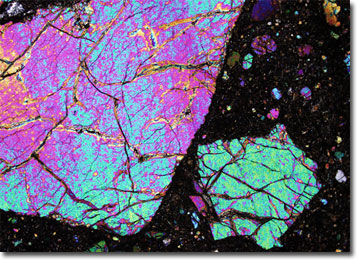Polarized Light Microscopy Digital Image Gallery
Olivine Basalt Porphyry
Porphyry is a term that refers to the texture of a rock, rather than its chemical or mineralogical composition. Indeed, porphyries are generally defined as igneous rocks that feature large, prominent crystals embedded in a finer groundmass matrix.

Porphyries are formed through two different phases of solidification. During the first stage, large crystals, usually referred to as phenocrysts, form within a body of magma. Then, the magma itself cools and solidifies. The result of this process can be quite various, the phenocrysts and groundmass exhibiting a wide range of characteristics. Porphyries, however, are usually classified by the type of phenocrysts found in the matrix.
Porphyritic basalts are relatively common and are found around the world. The phenocrysts contained in them vary somewhat, but are typically comprised of the silicate minerals pyroxene and olivine. Olivine is one of the most prolific substances found in the upper mantle of the Earth and has been found in meteorites as well. Typically green in color, perhaps the most familiar of these anisotropic minerals is peridot, a type of olivine that serves as the birthstone of August.
